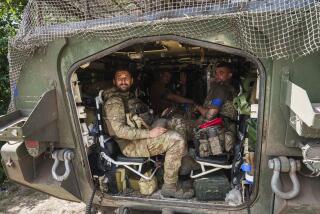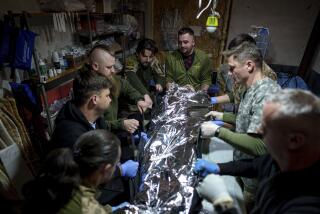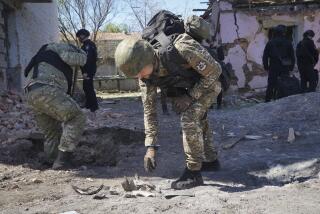Allies Push Ahead on 3 Fronts : 10,000 Prisoners Reported Taken in Kuwait, Iraq : Gulf War: Gen. Schwarzkopf calls the offensive a ‘dramatic success’ so far. U.S. casualties are reported to be light.
RIYADH, Saudi Arabia — Thrusting deeper into Iraq and Kuwait against little more than token resistance, U.S.-led ground forces pursued their swift campaign to rout Saddam Hussein’s troops along a 300-mile front--taking at least 10,000 prisoners in the first 24 hours of the campaign and advancing toward the Kuwaiti capital, military commanders said Sunday.
“They are moving north with great speed,” said Gen. H. Norman Schwarzkopf, commander of Operation Desert Storm. “So far, the offensive is progressing with dramatic success.”
Allied forces achieved “all of their first-day objectives” within the first 12 hours after the operation began, in an unexpected downpour of pre-dawn rain, Schwarzkopf said.
Schwarzkopf described Iraqi resistance as sporadic and allied casualties as “remarkably light,” but he gave no details. According to other sources, a total of three U.S. Marines, attached to the 1st and 2nd Marine divisions, were killed and 17 were wounded. Other sources reported a total of about two dozen U.S. troops wounded in the early hours of the ground offensive. Army officials said no Army personnel had been killed in the first 18 hours of the ground action.
Striking by land, sea and air, the allied offensive advanced along three fronts on the ground. To the east along the Persian Gulf coast, U.S. Marines pressed what was described as their largest land assault since World War II--smashing into Kuwait from the south along with Saudi and Kuwaiti armored troops.
To the west, American airborne troops pushed north into southwestern Kuwait, accompanied by helicopter gunships laying down a withering protective cover.
Still farther west, American, British and French armored forces struck directly into Iraqi territory, moving rapidly north in an apparent effort to cut off and encircle Iraq’s vaunted Republican Guard.
Military spokesmen in Saudi Arabia said U.S. Marines aboard ships in the Persian Gulf rushed ashore in an amphibious landing with anti-tank weapons for their fellow Leathernecks pushing north from the border. Sources in Washington said U.S. Special Forces and paratroopers of the 82nd Airborne Division were dropped near Kuwait city in a bold maneuver, but they added that the capital had not been secured.
In other developments during the first day of the ground campaign:
* Iraq insisted that the ground offensive “so far has totally failed” and asserted that the allied forces were “wading in their own blood” at Iraq’s defensive positions in and around Kuwait. Declaring that the Iraqi forces have already won, Baghdad Radio said, “Victory is sweet.”
* The Iraqi military fell back on a familiar tactic, firing two Scud missiles with conventional warheads at Saudi Arabia and two at Israel. Both the Scuds that hit Israel were reported to have exploded in a remote region of the southern part of country. There were no details on the locations of the other two. None of the missiles was believed to have caused any casualties or serious damage.
* Kuwaitis, anxiously anticipating their country’s liberation, announced that allies had captured the capital. Military sources confirmed only that allied troops are at the city’s gates, adding that bloody fighting may lie ahead.
* Analysts in several countries, including the United States, said the allied strategy is to envelop the 500,000-man Iraqi army in Kuwait and southern Iraq in a lightning-quick campaign and then either destroy it or force a surrender.
Along the Coast
Within two hours of the start of the offensive early Sunday, Marines had punched corridors through Iraqi-laid minefields in southern Kuwait to open the way for advancing troops near the Persian Gulf coast, according to reports from the front lines.
Columns of tanks, armored vehicles and infantry had moved at least 30 miles inside the Kuwaiti border by midday and attacked Iraqi positions northwest of the strategic Wafra oil fields, the reports said.
One Marine AV-8B Harrier was reported to have crashed, its pilot missing. And at least three tanks--each carrying a crew of four--were damaged or destroyed in fighting, military officials said.
More than 5,500 Iraqi troops surrendered Sunday, and “hundreds” more were seen waving white flags from their bunkers north of allied positions, an upbeat Schwarzkopf told reporters at a surprise press conference in Riyadh.
Later reports said more than 10,000 Iraqi prisoners had been captured in the ground battle’s first 24 hours. Cable News Network broadcast footage showing a line of Iraqi POWs stretching across the horizon as they were marched off to camps. Iraqi troops were reportedly desperately searching for anything white they could use to fashion a flag of surrender.
American officials said the Iraqis were surrendering en masse, creating problems for the rapidly moving allied forces. Despite being slowed by the Iraqi prisoners, allied air and armored units accomplished their first day’s objectives in the opening 12 hours of the land campaign, they said.
But Schwarzkopf and others cautioned that fighting would likely intensify as ground forces moved past Iraqi front-line troops and engaged the elite Republican Guard.
“The war is not over yet,” the commander said.
Asked whether allied forces were skirting Iraqi positions to hold down casualties, Schwarzkopf said: “We’re going to pursue them in any way it takes them to get out of Kuwait. We’ll go over, around, through, on top, underneath or any other way it takes.”
Schwarzkopf said Sunday’s heaviest fighting came when the Marine task force advancing along the Gulf coast clashed with an Iraqi armored unit. The Marines called in armor, anti-tank weapons and air cover to repulse the Iraqi counterattack. Several tanks were lost in the battle, he said.
“I would say that so far we are delighted with the progress of the campaign,” the general said.
Marine Lt. Col. Jan Huly said troops went into battle wearing full chemical protection suits and had been taking anti-nerve-gas pills for several days. But early reports that some chemicals had been detected in the air along the Kuwaiti-Saudi border proved false, Schwarzkopf said.
Sandy Gall, a war correspondent for Britain’s Independent Television News was with the Saudi forces moving directly north as part of the same assault.
Gall said that Iraqi foxholes seemed to be abandoned and empty and that white flags could be seen where Iraqis had surrendered.
“The Iraqis looked just as happy that their battle was over,” Gall said. “The Saudis sent the POWs back toward the allied lines and one of the best moments was when one of the Iraqi POWs kissed his Saudi captor, so relieved to be out of the war. As far as I could see, they offered medical aid and comfort to the POWs, who a short time before had been their bitter enemies.”
To the West
The British 1st Armored Division, including the fabled Desert Rats, moved into Iraqi territory west of Kuwait along with the U.S. 7th Corps, made up of the heaviest armored divisions in the American Army, and at least 9,000 French Foreign Legionnaires.
The armored columns conducted high-speed flanking operations, moving north toward the city of Nasiriyah on the Euphrates and northeast toward Basra and the encampments of the Republican Guard.
British soldiers described Iraqi front-line troops as “sleeping” on the job and said that many of them gave up to the onrushing allied troops.
“They are there to slow us down,” one soldier said. “But we knew we were going to roll right over them.”
One officer who escorted prisoners back to the allied lines said: “They are tired, hungry and thirsty. But apart from that, they are OK.”
But the division’s commander, British Maj. Gen. Rupert Smith, cautioned late Sunday: “We have a long way to go yet. This is but a beginning.”
A fleet of 300 assault helicopters from the 101st Airborne Division streaked deep into Iraq in a lunge aimed at cutting Saddam Hussein’s supply lines. The choppers established a forward refueling and rearming base to leapfrog deep into Iraqi territory.
No Iraqi aircraft left the ground, eliminating one concern of allied commanders, who feared that Iraq would try to launch kamikaze attacks with some or all of its remaining 400 aircraft.
“Saddam Hussein has betrayed his army,” a senior Army officer in Washington said. “He is leading them to their destruction. Armies don’t fight for guys like that.”
Noting that the allies have not yet encountered any organized Republican Guard or other armored units, this official warned: “The worst is yet to come.”
In Kuwait
Kuwait city, the capital that was so dramatically overrun by Iraqi troops and tanks on Aug. 2, is where some of the hardest fighting may yet remain, in streets and buildings where urban combat can become a bloody struggle to pry loose an entrenched enemy.
In the first hours after the ground war began, Kuwaiti officials in exile were reporting that the city was already in allied hands, with paratroopers dropping into the capital and amphibious landings being conducted in two suburbs.
Military sources in Washington acknowledged that U.S. Special Forces and paratroopers of the 82nd Airborne Division have been dropped into and around Kuwait city, but said the city has not been secured.
The U.S. Navy denied a report from the exiled Kuwaiti government that allies had captured the island of Faylakah off the coast of Kuwait city, a key strategic point that commands sea access to the capital.
After last week, when Iraqis were reportedly executing Kuwaitis by the score, Kuwaitis inside the country have told their exiled government that Iraqi troops appear to have suspended arrests and executions since the ground war began, Kuwaiti spokesman Ayman Sebaie said.
“After the ground war, I think the only thing they are thinking about is their own lives,” he said.
But there were allied reports that Iraqi forces were rounding up Kuwaitis to “execute” them in the streets, and that Iraqis were blowing up or burning key buildings, including the Kuwaiti Parliament and other structures. Kuwaiti exiles described the city as a wrecked shell, with burned cars and dead animals littering the streets. Nearly 300 oil wells put to the torch by the Iraqis had thrown a pall of black smoke across the city and much of Kuwait, according to allied commanders.
“If they get us in there in urban warfare, they can really cause the casualties that Saddam Hussein is looking for--blood for blood,” said Jeff Shaffer, a military analyst with the Center for Strategic and International Studies.
A senior U.S. military source cautioned that street fighting in Kuwait city “could be very slow.”
So could rebuilding the recaptured city.
Fahad Hasawi, Kuwait’s minister for municipal affairs, said Sunday that once his country is freed, the government will launch a 90-day emergency program to repair basic services, including water, sewers, communications and hospitals.
Kuwait has signed $1.25 billion in contracts to rebuild the country’s infrastructure, most of them with U.S. firms, Hasawi said.
The Strategy
Senior British defense officials said the heavy armored columns moving overland but quickly northward have the option of continuing toward Basra, thus cutting off Iraqi communications to the north and striking directly at the Republican Guard based along the northern Kuwaiti border with Iraq, or wheeling east toward Kuwait city to surround other enemy forces.
Echoing that scenario, Agence France-Presse reported that the allied goal is to catch the Republican Guard units deployed along the Kuwait-Iraq border in a pincers movement, with French-commanded troops arriving from the West and American and other allied forces from the south and east.
“The allies appear to have rejected the strategy of a frontal battle with the Iraqi front lines in Kuwait,” the news service reported. “The attempt would be to skirt the Iraqi lines, showing restraint until they are encircled, then smother them by closing them progressively on themselves . . . like two hands strangling someone.”
Israeli analysts cautioned that Iraq may yet be holding its troops in reserve for its own counterattack.
“The main thing is to put down the Republican Guards,” said Avraham Rotan, a retired Israeli general.
Wilkinson reported from Riyadh and Broder from Washington. Times staff writers Daniel Williams in Jerusalem, William Tuohy in London and Rone Tempest in Paris contributed to this story.
THE ALLIED GROUND OFFENSIVE
The long-anticipated ground war started as a massive, multi-pronged attack involving troops from 11 countries, mobile armor, airborne attacks and support from the sea. Military sources and press reports indicated that the land attacks struck in three directions. The common elements throughout were speed and mobility. Resistance was light, and thousands of Iraqi prisoners were taken:
1. British troops launched a major flanking attack from Saudi Arabia into Iraq. The British were believed to be pushing toward Basra, Iraq’s second-largest city, or heading toward Kuwait city, encircling Iraqi troops in either case.
2. U.S. and French forces pushed into Iraq west of Kuwait. Reports had these armored troops at least 30 miles past the Saudi border.
3. U.S. airborne troops with quick-strike helicopter capability moved into southwest Kuwait.
4. Along the Gulf, U.S. Marines moved northward into Kuwait, along with Saudi Arabian and Kuwaiti armored elements.
5. Some U.S. forces were reported near Kuwait city. The quick recapture of the capital city is considered a high priority.
6. Early reports that U.S. Marines had taken the strategic island of Faylakah off Kuwait city were denied. Other unconfirmed reports said Marine amphibious troops had landed in Kuwait city suburbs.
THE WORD FROM THE TOP
The first words aired by the opposing generals: Gen. H. Norman Schwarzkopf
“Friendly casualties have been extremely light--as a matter of fact, remarkably light. So far, the offensive is progressing with dramatic success, the troops are doing a great job, but I would not be honest with you if I didn’t remind you that this is the very early stages. We’re a little more than 12 hours into this offensive, and the war is not over yet.”
Saddam Hussein’s broadcast
“Fight them, oh brave, splendid men. Oh men of the mother of battles. . . . Fight them with your faith in God. Fight them in defense of every free and honorable woman and every innocent child, and in defense of the values of manhood, values, and the military honor which you shoulder. Fight them because with their defeat you will be at the last entrance of the victory of victories. . .”
ALLIES JOINING THE GROUND OFFENSIVE
The massive entry into Kuwait from air, sea and ground involved huge numbers of allied forces under a variety of commands. Among the countries taking part:
GROUND TROOPS
United States
Britain
Kuwait
Egypt
Syria
Saudi Arabia
France
NAVAL FORCES
United States
Britain
Kuwait
AIR FORCES
United States
Britain
Saudi Arabia
Italy
Canada
United Arab
Emirates
Bahrain
Qatar
More to Read
Sign up for Essential California
The most important California stories and recommendations in your inbox every morning.
You may occasionally receive promotional content from the Los Angeles Times.











